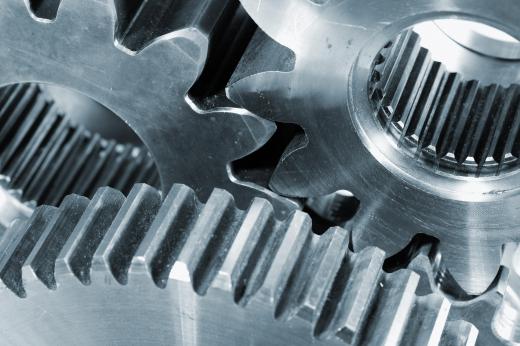A gear tooth is a protrusion on a gear which is designed to mesh with compatible teeth on another gear or rack. Many people are familiar with the concept of gear teeth, even if they don't know the proper name for this part of a gear, because the teeth are what give gears their distinctive look. There are a variety of different styles of gear and gear teeth which can be used in various applications, but all of them are used to transfer force in order to perform mechanical work.
As one gear is turned, its teeth intermesh with those of a partner gear, with each gear tooth meeting a corresponding gap between teeth on the other gear. This causes the other gear to turn, transferring the force used to turn the first gear to the second gear. The advantage to the design is that it creates a mechanical advantage which can be adjusted by increasing or decreasing the ratio of the partner gears, making for greater efficiency.

The teeth or “cogs” on a gear can be adjusted in a number of ways. The size of a gear tooth makes a big difference, as differently-sized teeth cannot intermesh well. The larger the gear, the larger the teeth tend to be, although this is not always the case. The angle of the teeth is also an issue in gear design. To intermesh well, gears need to have compatible angles. The pitch or distance between the teeth is yet another factor in the configuration of gears.

Gear teeth can also be set at an angle or bias on the gear itself, in a departure from the classic straight teeth of a traditional gear. In helical gears, for example, the teeth wrap around the gear in a spiral pattern, allowing the gear to mesh more smoothly and evenly with other gears. Well-designed helical gears can work parallel to other gears, or at a 90 degree angle, something which comes in useful in design when engineers want to be flexible.

Because a gear tooth protrudes from a gear, it is vulnerable to damage. Gear teeth can be damaged by other gears, as for example when an inexperienced driver grinds the gears of a manual transmission, and they are also subject to wear and tear over time. A gear tooth can chip, crack, and eventually fail, even with the most careful maintenance. Some gears are specifically designed to reduce wear and tear, prolonging the life of the gear and reducing the need for maintenance.
